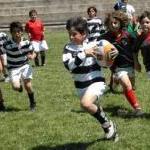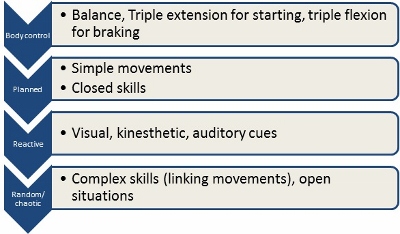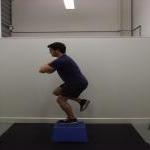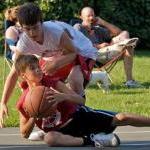4 steps to get more agile in pre-season.
It’s better to run around people than through them.
 The ability to run “through spaces not faces” is very important in most field/court sports. You want to be agile enough to:
The ability to run “through spaces not faces” is very important in most field/court sports. You want to be agile enough to:
- Avoid being tackled
- Be able to get into a position to stop your opponent
- Get to the ball.
Is your pre-season agility training helping you achieve this?
Do you have a series of ladders and cones laid out and run around them?
 Or, are you really advanced and have a slalom series of poles laid out? Does that get players more agile, or just more tired?
Or, are you really advanced and have a slalom series of poles laid out? Does that get players more agile, or just more tired?
Small-sided games are very popular, and one coach said to me “Gareth Edwards never needed coaching”. Nope, but he grew up at an age when kids played British Bulldog and kick the can, and had proper PE lessons where they had to get hot and sweaty.
Nowadays, your team is made up of desk jockeys or couch potatoes, so the basics have to be built in and reinforced whatever your level.
Agility training should be more than Organised Despair. It requires coaching, progression, variety and application.
A 4 Step Approach to Getting More Agile
Here is our approach to getting players more agile.

1 Body Control.
This is the foundation where the importance of strength and balance are emphasised. This allows better force reduction, force stabilisation and then force production.
 The use of Single Leg Squats, multi-directional lunges, multi-directional hop and holds are essential. For the upper body, the use of lawnmower sprawls and sit throughs are coached.
The use of Single Leg Squats, multi-directional lunges, multi-directional hop and holds are essential. For the upper body, the use of lawnmower sprawls and sit throughs are coached.
These then become part of the Team’s warm-up drills.
(Get your Free 5-day agility training programme here)
2 Planned Movements. Turn and Run, Rolling and Crawling mechanics.
Coach the push-off 2 feet in different directions: forward, side and backwards. The open step and crossover step are both practised.

Practise getting up off the floor
Agility is not just important when standing up. A lot of time is spent getting up and down off the floor in sport. Players need to be taught how to land safely and then get back up quickly.
Forward rolls, sideways rolls, and backward rolls are all important parts of this. Bear crawls are useful to help teach sprint mechanics from the floor and short distance acceleration. These can then be combined to form a warm-up sequence like this video.
This is then rehearsed in drills like the Oregon Sway Drill and Foot Dot Drill.
3 Reactive Drills.
Once your players have practised their mechanics and learnt how to use them in sequence, you can start getting them to react to different stimuli.
 This puts time pressure into place and you can see how robust the players’ techniques are. The cues can be:
This puts time pressure into place and you can see how robust the players’ techniques are. The cues can be:
- Visual (partner or coach moving, a ball moving)
- Auditory (left, right, go, or the sound of a ball being kicked)
- Kinesthetic (partner push, feel of the ball on feet)
4 Random and Chaotic Games and skills drills.
Now is the chance to put the different movements into place. For example, having your players work on a 2 vs 1 drill in a narrow linear channel would follow on from the Foot Dot Drill.

Excelsior athlete Dan James
Having them work on a 3 vs 2 in a wide lateral channel would follow on from the Oregon Sway Drill.
This gives the players the chance to rehearse in a “limited open game“. There are specific rules and boundaries, but decisions have to be made and reactions and agility are tested.
You can do all four of these sequences in each session: If you spend 5 minutes on each part, then you are progressing through the learning process. After 20 minutes your players will be warmed up, be moving better, and have had to practise making decisions.
How to Test Pre-Season Agility
Agility is the ability to change direction at a pace in response to a stimulus. Unfortunately, most agility testing just measures the ability to change direction at pace, without an appropriate stimulus.
As you may have gathered from our previous posts on Pre-season training, we are not fans of testing for testing sake. If you do test agility, be aware that you are measuring your players’ ability to accelerate, brake and change direction.
Do not use the test as a selection process as decision-making is not measured.
The 3-cone L weave is an easily administered agility test, that measures the change of direction of both feet in a speed cut and a power cut.
Next week, we will look at getting your team faster in Pre-season.

[…] spent some time going through agility progressions and the 7 steps to running faster with the […]
[…] every action he was doing. That is something I learnt from Steve Morris and I incorporate into the agility work I do with every […]
[…] However due to it being such a small court having the ability to move laterally is also very important especially in regards to limiting injury. Therefore in terms of training the athlete can be doing lateral squats and two-foot lateral base, where the athlete moves side to side until a partner shouts stop (more agility work here) […]
[…] exercises and barbell exercises (especially squats and deadlifts). We moved outside to do agility training (hip projection being key) and finally speed and […]
[…] is the first step of our 4 step progression to improving […]
[…] How to be more agile […]
[…] right are the athletes setting up the Sway Drill one of the agility progressions they worked […]